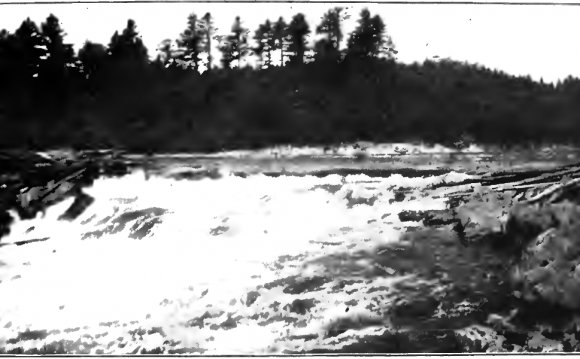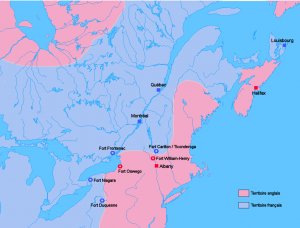
 Long Answer:
Long Answer:
Twenty-some years before the American Revolution (1754), which was just before the Seven Years War, this is what the map of British Colonies looked like: Only a few areas of modern-day Canada were British then: Nova-Scotia, Labrador-Newfoundland, and around James' Bay & Hudson's Bay. Quebec extended south to below Niagara falls.
1.) Geographic Separation caused the English speaking British colonies north of Maine to be culturally distinct from the 13 American Colonies. The people of Nova Scotia were half New Englanders and half Germans, Highlanders, Ulstermen and Yorkshiremen. Nova Scotia wished to remain neutral. British Naval power and a British Garrison at Halifax prevented any serious American attempt at invasion. In 1777 Nova-Scotian outposts came under attack from New England privateers seeking plunder. That caused even former New-Englanders to form militias and defend their homes. Soon thereafter the New Light religious movement (Great Awakening) started by Henry Alline of Rhode Island swept through New England and Nova Scotia turning attention away from Politics.
2.) Acceptance of British Rule: When New France fell in 1760, the defeated armies, French officials, some seigneurs, and some merchants returned to France. British credit, currency, and markets such as London was what mattered-not Paris or America. The British successfully implemented representative government in Quebec through respecting the religious freedoms of Catholics and recognizing the political value of the Catholic Church, which was backed by a dutiful French populace that contrasted sharply with the restive 13 American colonies.
3.) The Quebec Act of 1774 satisfied Quebec and angered the American colonies. It allowed English criminal law to exist in parallel with French civil law and the entrenched seigneurial system. Quebec even had a (legal) mandatory tithe to the Catholic Church, which only concerned Catholics.
The Quebec Act also expanded the province of Quebec to include Labrador in the East and extended the Western boundary to the junction of the Ohio and Mississippi rivers all the way north to Rupert's Land. This expansion had the obvious intent of funneling the fur-trading areas serviced through the St. Lawrence into the jurisdiction of Quebec. The land was mainly Indian territory (where the Indians were allied with the French) that was exploitable for the fur trade without endangering Indian land rights and risking war.
American colonists desired to settle these native lands, and therefore listed the Quebec Act as one of the "Insufferable Acts."
4.) Cultural and Religious Isolation: Quebec was the largest British colony in what is now Canada. The language barrier combined with the foreign religion of French Quebec and the history of hostilities from the Seven Years War caused Americans to view the people of Quebec as foes.
5.) Patriot attacks on Canadiens solidified opposition to the American revolution. American Patriot generals Richard Montgomery and Benedit Arnold Attacked Quebec in an attempt to seize Canada from British control (1775). They took Montreal and laid siege (ultimately unsuccessfully) to Quebec City, where British regulars and a few Canadien militia defended. The Americans were ill-supplied but stayed till spring, when the British navy sailed up the St. Lawrence.
It also became true that in the wartime alliance reached in 1778 between France and the young American republic, neither partner really wanted to see the other established at Quebec, preferring to have it left to Britain rather than that either of the two new "friends" should hold it.
6.) Economic Interests: The merchants of British North-America benefited from the influx of British troops (and money) which powered the offense south from Quebec. The Canadians also profited from access to the tariff-protected British markets, which far larger New England competitors had forfeited through the act of war. The fur market in particular began to thrive in Canada. The British Navy on the Atlantic and by British military power in the interior both guarded the fur trade.
Businessmen came to recognize that their economic stake in the imperial system far outweighed any political discontent over the Quebec Act - and that Act, after all had re-attached the valuable southwest fur domains to Canada. Hence the merchants' sense of commitment increased with the flow of trade on into the 1780s; as they saw that their St. Lawrence commercial realm was tied both to Britain and to Canada's own growth westward. Factors of geography and business interest in effect were shaping the prime leaders of Montreal into British imperialists and Canadian economic nationalists combined.
RELATED VIDEO












